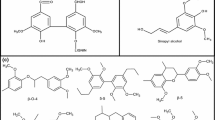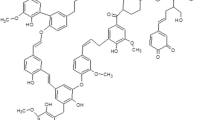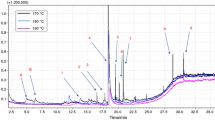Abstract
The ability of the lignin-degrading microorganism Phanerochaete chrysosporium to attack polyethylene and polypropylene was investigated using a series of polymer blends containing 10, 20 and 30% lignin obtained from the waste product of pulp and paper industry. In the cultivation medium, lignin peroxidase and Mn(II)peroxidase activities were detected. Degradation was verified by quantitative u.v. spectrophotometric analysis of the cultivation medium and by liberation of CO2 from the blends. Measurement of the tensile strength after 30-days cultivation showed that the mechanical properties of the polymer blends were decreased during the biodegradation process. The isolation of oligomer fractions by tetrahydrofuran (THF) extraction of biodegraded polymers and their characterization by gel permeation chromatography (GPC), u.v. and Fourier transmission infrared (FTIR) spectroscopy indicates that biotransformation of the lignin component during the cultivation process initiates partial biodegradation of the synthetic polymer matrix.
Similar content being viewed by others
References
Albertsson, A.C. 1978 Biodegradation of synthetic polymers. II. A limited microbial conversion of 14C in polyethylene to 14CO2 by some soil fungi. Journal of Applied Polymer Science 22, 3419–3433.
Alexy, P., Košíková, B. & Podstránska, G. 2000 The effect of blending lignin with polyethylene and polypropylene on physical properties. Polymer 41, 4901–4908.
Backa, S., Gierer, J., Reitberger, T. & Nilsson, T. 1993 Hydroxyl radical activity associated with the growth of white-rot fungi. Holzforschung 47, 181–197.
Chua, M.G.S., Chen, C.L. & Chang, H.M. 1982 13C NMR spectroscopic study of spruce lignin degraded by Phanerochaete chrysosporium. Holzforschung 36, 165–172.
Cornell, J.H., Kaplan, A.M. & Rogers, M.R. 1984 Biodegradability of photooxidized polyalkylenes. Journal of Applied Polymer Science 29, 2581–2597.
Daniel, G., Nilsson, T. & Pettersson, B. 1989 Intra-and extracellular localization of lignin peroxidase during the degradation of solid wood and wood fragments by Phanerochaete chrysosporium by using transmission electron microscopy and immunologold labeling. Applied and Environmental Microbiology 55, 871–881.
Geetha, R., Torikai, A., Nagaya, S. & Fueki, K. 1987 Photooxidative degradation of polyethylene: effect of polymer characteristics on chemical changes and mechanical properties. Part 1 — Quenched polyethylene. Polymer Degradation and Stability 19, 279–292.
Glasser, W.G., Barnett, C.A., Muller, P.C. & Sarkanen, K.V. 1983 The chemistry of several novel bioconversion lignins. Journal of Agriculture and Food Chemistry 31, 921–930.
Kačík, F., Solár, R. & Melcer, I. 1992 Gel permeation chromatography of lignins on the Separon Hema Columns. Wood research 135, 39–48.
Kirk, T.K., Schultz, E., Connors, W.J., Lorenz, L.F. & Zeikus, J.G. 1978 Influence of culture parameters on lignin metabolism by Phanerochaete chrysosporium. Archives of Microbiology 117, 277–285.
Košíková, B., Demianová, V. & Kačuráková, M. 1993 Sulfur-free lignins as composites of polypropylene films. Journal of Applied Polymer Science 47, 1065–1073.
Košíková, B., Revajová, A. & Demianová, V. 1995 The effect of adding lignin on modification of surface properties of polypropylene. European Polymer Journal 31, 953–956.
Kuwahara, M., Glenn, J.K., Morgan, M.A. & Gold, M.H. 1984 Separation and characterization of two extracellular H2O2-dependent oxidases from ligninolytic cultures of Phanerochaete chrysosporium. FEBS Letters 169, 247–250.
Lee, B., Pometto, A.L., Fratzke, A. & Bailey, T.B. 1991 Biodegradation of degradable plastics polyethylene by Phanerochaete and Streptomyces species. Applied and Environmental Microbiology 57, 678–685.
Miller, G.L. 1959 Dinitrosalicylic acid reagent for determination of reducing sugars. Analytical Chemistry 31, 426–428.
Tien, M. & Kirk, T.K. 1984 Lignin-degrading enzyme from Phanerochaete chrysosporium. Purification, characterization and catalytic properties of a unique H2O2-requiring oxygenase. Proceedings of the National Academy of Sciences USA 81, 2280–2284.
Torikai, A., Shirakawa, H., Nagaya, S. & Fueki, K. 1990 Photodegradation of polyethylene: factors affecting photostability. Journal of Applied Polymer Science 40, 1637–1646.
Author information
Authors and Affiliations
Rights and permissions
About this article
Cite this article
Mikulášová, M., Košíková, B., Alexy, P. et al. Effect of blending lignin biopolymer on the biodegradability of polyolefin plastics. World Journal of Microbiology and Biotechnology 17, 601–607 (2001). https://doi.org/10.1023/A:1012415023385
Issue Date:
DOI: https://doi.org/10.1023/A:1012415023385




